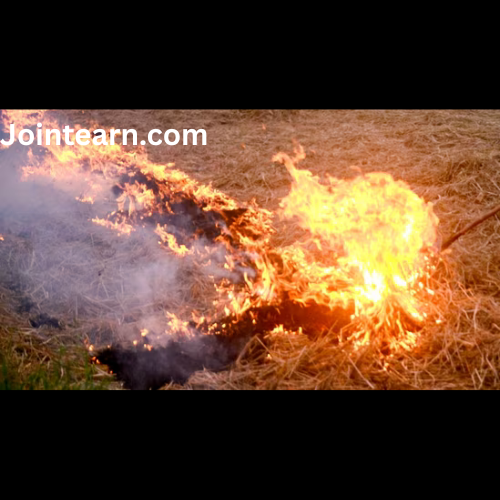
Pakistan has witnessed an unprecedented surge in farm fires in October, setting alarm bells ringing among meteorologists and environmental experts across South Asia. In the ten-day period ending October 25, Pakistan recorded 3,730 farm fires, the highest count for the same period in records dating back to 2012. The rising frequency of these fires has raised concerns about potential cross-border pollution, particularly for India’s northern states, including Delhi, which is already grappling with seasonal air quality challenges. Experts, however, emphasize that, for now, these fires have not directly contributed to Delhi’s pollution, thanks to prevailing wind patterns, but caution that the situation could change in the coming days.
The current spike in farm fires has been attributed primarily to local factors within Pakistan, including the rapid harvesting and clearing of paddy fields to prepare for winter crops. Satellite data from NASA’s Visible Infrared Imaging Radiometer Suite (VIIRS) shows that the spike in October has been concentrated in the second half of the month. From October 16 to October 25, Pakistan recorded the highest number of farm fires in a ten-day span since 2012, surpassing even the 3,492 fires observed during the same period in 2021. In total, Pakistan’s fire count for October 1-25 reached 5,908, marking the fourth-highest October tally in the past 13 years.
Despite this alarming figure, the impact on India’s air quality has, for the time being, been limited. Delhi’s Air Quality Index (AQI) climbed to 292 (“poor”) on Saturday afternoon, up from 275 a day earlier, following a brief improvement on Friday when stronger winds helped disperse Diwali-related firecracker pollution. By 11 pm, the AQI had further deteriorated to 310 (“very poor”), reflecting a return to pre-winter pollution levels. Experts, however, note that the current spike is largely due to local emissions and urban pollutants, rather than the smoke from Pakistani farm fires.
Meteorologists explain that the direction and speed of prevailing winds are crucial in determining whether cross-border smoke will affect Delhi. At present, winds are blowing from west to east, diverting the smoke from Pakistan over Punjab and parts of Jammu and Kashmir. As a result, the particulate matter from these fires has not yet reached the national capital. Madhavan Nair Rajeevan, former secretary of India’s Ministry of Earth Sciences, explained that the situation could change after a western disturbance passes through the region between October 27-29. During this period, winds are expected to shift to northwesterlies, potentially carrying smoke from Pakistan and northwest India toward Delhi and the wider Indo-Gangetic Plain.
“Once the wind shifts, particulate matter from these fires could significantly increase air pollution levels in the capital,” Rajeevan warned. “The impact will depend on wind speed, but the combination of stubble burning and local emissions could lead to a spike in AQI, especially during morning and evening hours when temperature inversions trap pollutants near the surface.”
This forecast underscores the seasonal pattern that has long affected northern India. Every year, pre-winter meteorological conditions, including calm winds, low temperatures, and temperature inversions, trap pollutants in the lower atmosphere. When combined with smoke from agricultural fires, this often leads to public health emergencies in the National Capital Region (NCR), with AQI levels frequently exceeding 400, classifying the air as “hazardous.”
Another expert, Ashwary Tiwari of IndiaMetSky, echoed Rajeevan’s assessment, noting that while the current wind patterns have protected Delhi, the high number of farm fires in Pakistan is likely to have a delayed impact. “Once the upcoming western disturbance moves away, northwesterly-westerly winds are expected to return over the northern plains. At that point, smoke and particulate matter from Pakistan’s farms could accumulate over the Indo-Gangetic Plain, moderately affecting air quality in Delhi and surrounding areas,” he said. Tiwari added that transport-level winds are expected to be strong during this period, potentially facilitating the movement of pollutants across long distances.
Interestingly, the spike in Pakistan contrasts sharply with Punjab’s current burning season, which is at historically low levels. During the same ten-day period ending October 25, Punjab recorded just 498 fires, marking the lowest count since 2012. By comparison, the same period in 2016 saw 15,150 fires, while 2022 recorded 5,121. For the full October 1-25 period, Punjab has recorded only 661 fires, well below the 2012-2021 average of 11,877 fires.
Despite this apparent lull, experts caution that the low fire count may not persist. Only 52.28% of Punjab’s 3.17 million hectares under paddy cultivation had been harvested as of October 25, according to the Punjab Pollution Control Board (PPCB). With just over half the crop cleared and a narrowing window for wheat sowing, there is a high likelihood that farmers will accelerate stubble burning in the coming days to prepare their fields, which could sharply increase particulate matter levels across northwest India.
“Farmers are under time pressure to clear fields before the next crop cycle, so we expect the next few days to see a surge in stubble burning,” said an unnamed PPCB official. Such an increase, combined with shifting wind patterns, could exacerbate pollution levels across the Indo-Gangetic Plains, including Delhi, which already faces heightened exposure to PM2.5 particles during the winter season.
Current meteorological conditions also play a crucial role in determining the short-term pollution load. On Saturday, local wind speeds were relatively calm, but the direction was mixed, causing pollutants from neighboring areas like Gurugram, Ghaziabad, Sonipat, and Gautam Buddha Nagar to accumulate in Delhi. This factor, more than the distant fires in Pakistan, contributed to the slight spike in the AQI observed over the weekend, according to Sunil Dahiya, founder and lead analyst at think-tank Envirocatalysts.
The delayed harvesting pattern in Punjab mirrors trends from last year, when the state recorded 31,023 fires for October-November 2023. That year also saw an unusual spike in mid-November, with fire counts reaching around 1,700 daily between November 14 and 16—a period that usually shows declining activity. Such patterns indicate that even when early-season fires are low, sudden surges can occur later, depending on harvest schedules and crop management practices.
Meteorologists emphasize that the eventual impact of smoke on Delhi’s air quality will depend on the interplay of multiple factors: wind direction, wind speed, and local emissions. Mahesh Palawat, vice president at Skymet Weather, noted that the current west-to-east wind direction has prevented Pakistani smoke from affecting Delhi so far. “The contribution of stubble burning to pollution is highly dependent on meteorological conditions like wind direction and speed. When the winds shift to northwesterlies after the western disturbance, smoke from Pakistan could travel over Delhi and NCR,” he explained. The disturbance is also expected to bring clouding, light rain, and snowfall to the hills, which could influence the dispersion and deposition of pollutants.
Experts caution that once the smoke reaches Delhi, its effects will be visible in multiple ways. AQI levels are likely to spike during early mornings and late evenings, while the lower atmosphere between 1,000 to 6,000 feet may become hazy due to suspended soot and smoke particles. The sky could take on a grey, muted appearance, partially blocking sunlight and contributing to deteriorating air quality for urban populations.
In conclusion, while Pakistan’s farm fires have set record counts for this October, their immediate impact on Delhi’s air quality remains limited due to prevailing meteorological conditions. However, with a western disturbance expected to shift wind patterns and stubble burning likely to surge in both Pakistan and Punjab, northern India may soon face significant pollution challenges. Authorities and residents alike are being advised to monitor air quality closely, especially during mornings and evenings, and to prepare for the compounded effects of local and transboundary emissions that traditionally define Delhi’s pre-winter air quality crises.

Leave a Reply